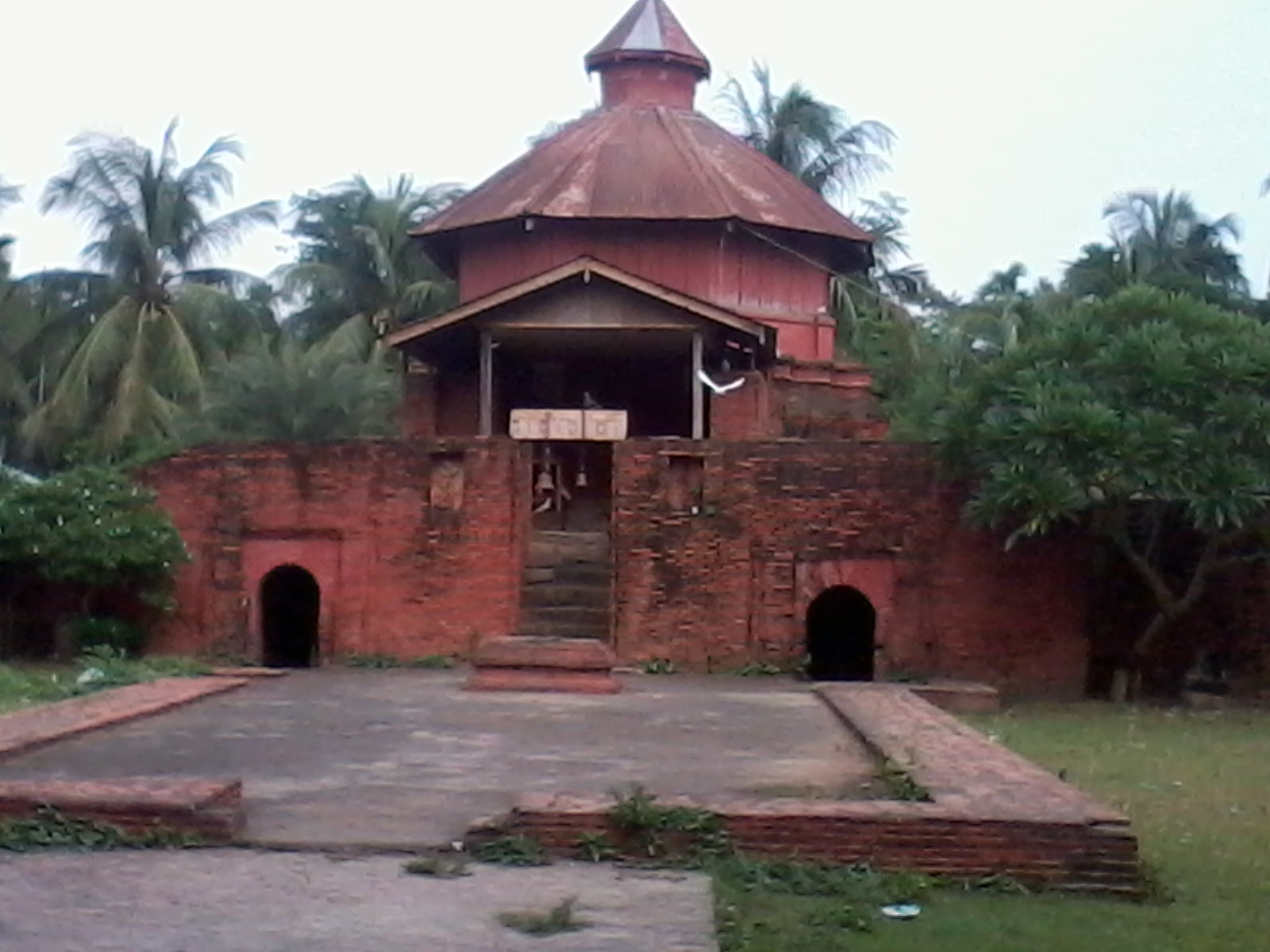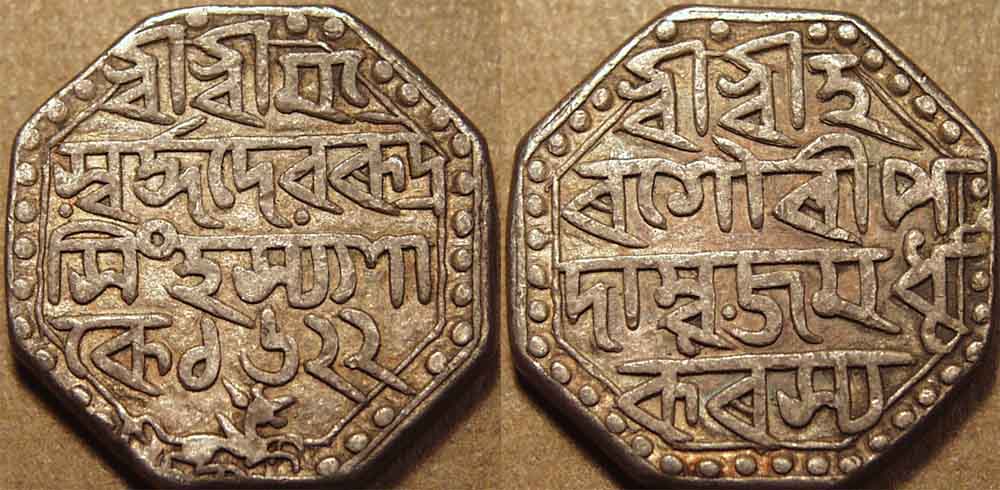|
Rudreswar Temple
The Rudreswar Temple or Devaloya is a temple dedicated to Lord Shiva in the village of Rudreswar, under Sila Sindhurighopa Mouza (revenue circle), on northern bank of the river Brahmaputra, in Guwahati. Built in 1749 CE by Ahom king Pramatta Singha, in memory of his father Swargadeo Rudra Singha, the temple is a fine example of a mixed style of Ahom-Mughal architecture. History In the latter part of his reign, Swargadeo Rudra Singha announced his desire to expand Assam westward as far as the river Karatoya in present-day West Bengal and Bangladesh, which was considered the frontier of the ancient Kamarupa kingdom. Some sources also indicate that his ambition was to include a portion of the sacred Ganga river within his domain. Since Bengal was under the rule of the Mughals, he began to prepare for a massive military expedition against the Mughal Empire. An army of approximately 400,000 soldiers gathered in Guwahati, in which various tribes from the hills and plains came togethe ... [...More Info...] [...Related Items...] OR: [Wikipedia] [Google] [Baidu] |
Shiva
Shiva (; sa, शिव, lit=The Auspicious One, Śiva ), also known as Mahadeva (; ɐɦaːd̪eːʋɐ, or Hara, is one of the principal deities of Hinduism. He is the Supreme Being in Shaivism, one of the major traditions within Hinduism. Shiva is known as "The Destroyer" within the Trimurti, the Hindu trinity which also includes Brahma and Vishnu. In the Shaivite tradition, Shiva is the Supreme Lord who creates, protects and transforms the universe. In the goddess-oriented Shakta tradition, the Supreme Goddess ( Devi) is regarded as the energy and creative power (Shakti) and the equal complementary partner of Shiva. Shiva is one of the five equivalent deities in Panchayatana puja of the Smarta tradition of Hinduism. Shiva has many aspects, benevolent as well as fearsome. In benevolent aspects, he is depicted as an omniscient Yogi who lives an ascetic life on Mount Kailash as well as a householder with his wife Parvati and his three children, Ganesha, Kartikeya and A ... [...More Info...] [...Related Items...] OR: [Wikipedia] [Google] [Baidu] |
Meghalaya
Meghalaya (, or , meaning "abode of clouds"; from Sanskrit , "cloud" + , "abode") is a states and union territories of India, state in northeastern India. Meghalaya was formed on 21 January 1972 by carving out two districts from the state of Assam: (a) the United Khasi Hills and Jaintia Hills and (b) the Garo Hills.History of Meghalaya State Government of India Meghalaya was previously part of Assam, but on 21 January 1972, the districts of Khasi, Garo and Jaintia Hills became the new state of Meghalaya. The population of Meghalaya as of 2014 is estimated to be 3,211,474. Meghalaya covers an area of approximately 22,430 square kilometres, with a length-to-breadth ratio of about 3:1.Meghal ... [...More Info...] [...Related Items...] OR: [Wikipedia] [Google] [Baidu] |
1897 Assam Earthquake
The Assam earthquake of 1897 occurred on 12 June 1897, in Assam, British India at 11:06 UTC, and had an estimated moment magnitude of 8.2–8.3. It resulted in approximate 1,542 human casualties and caused catastrophic damage to infrastructures. Damage from the earthquake extended into Calcutta, where dozens of buildings were severely damaged, with some buildings partially collapsing. Trembles were felt across India, reaching as far as Ahmedabad and Peshawar. Seiches were also observed in Burma. Earthquake The earthquake occurred on the south–southwest-dipping reverse Oldham Fault that forms the northern edge of the Shillong Plateau. There was a minimum displacement on the main fault of 11 m, although some calculations have placed this figure at as high as 16 m; one of the greatest for any measured earthquake. The calculated area of slip extended 180 km along the strike and from 9–45 km beneath the surface, indicating that the entire thickness of the c ... [...More Info...] [...Related Items...] OR: [Wikipedia] [Google] [Baidu] |
United Kingdom
The United Kingdom of Great Britain and Northern Ireland, commonly known as the United Kingdom (UK) or Britain, is a country in Europe, off the north-western coast of the continental mainland. It comprises England, Scotland, Wales and Northern Ireland. The United Kingdom includes the island of Great Britain, the north-eastern part of the island of Ireland, and many smaller islands within the British Isles. Northern Ireland shares a land border with the Republic of Ireland; otherwise, the United Kingdom is surrounded by the Atlantic Ocean, the North Sea, the English Channel, the Celtic Sea and the Irish Sea. The total area of the United Kingdom is , with an estimated 2020 population of more than 67 million people. The United Kingdom has evolved from a series of annexations, unions and separations of constituent countries over several hundred years. The Treaty of Union between the Kingdom of England (which included Wales, annexed in 1542) and the Kingdom of Scotland in 170 ... [...More Info...] [...Related Items...] OR: [Wikipedia] [Google] [Baidu] |
Upper Terrace Of Rudreswar Temple
Upper may refer to: * Shoe upper or ''vamp'', the part of a shoe on the top of the foot * Stimulant, drugs which induce temporary improvements in either mental or physical function or both * ''Upper'', the original film title for the 2013 found footage film '' The Upper Footage'' See also {{Disambiguation ... [...More Info...] [...Related Items...] OR: [Wikipedia] [Google] [Baidu] |
Notice Of ASI In English In Rudreswar Temple
Notice is the legal concept describing a requirement that a party be aware of legal process affecting their rights, obligations or duties. There are several types of notice: public notice (or legal notice), actual notice, constructive notice Service of process At common law, notice is the fundamental principle in service of process. In this case, the service of process puts the defendant "on notice" of the allegations contained within the complaint, or other such pleading. Since notice is fundamental, a court may rule a pleading defective if it does not put the defendant on notice. In a civil case, personal jurisdiction over a defendant is obtained by service of a summons. Service can be accomplished by personal delivery of the summons or subpoena to the person or an authorized agent of the person. Service may also be made by substituted means; for example, in many jurisdictions, service of a summons can be made on a person of suitable age and discretion at the residence or pl ... [...More Info...] [...Related Items...] OR: [Wikipedia] [Google] [Baidu] |
Rudra Singha
Sukhrungphaa (reigned 1696–1714), or Swargadeo Rudra Singha, was a Tungkhungia ahom king and 30th king of the Ahom kingdom under whom the kingdom reached its zenith of power and glory, he is considered as the most illustrious of the Ahom kings. At Gadadhar Singha's death, his elder son Lai ascended the throne with the Ahom name of Sukharngpha and the Hindu name of Rudra Singha. An illiterate (probably dyslexic), he is best known for building a coalition of rulers in the region and raising a vast composite army against the Mughal Empire. He died on the eve of his march west from Guwahati. He had subjugated the Jayantias and the Kachari kingdoms in (1707). He built a new capital at Meteka and named it as Rangpur. Rudra Singha, following the words of his father, decided to reinstate the Vaishnava Gosain and Mahantas, he had settled the Satras in Majuli being nearer to the Ahom metropolis. He had received the initiation of Auniati Gosain, Haridev. He had invited the Benga ... [...More Info...] [...Related Items...] OR: [Wikipedia] [Google] [Baidu] |
Ahom People
The Ahom (Pron: ), or Tai-Ahom is an ethnic group from the Indian states of Assam and Arunachal Pradesh. The members of this group are admixed descendants of the Tai people who reached the Brahmaputra valley of Assam in 1228 and the local indigenous people who joined them over the course of history. Sukaphaa, the leader of the Tai group and his 9000 followers established the Ahom kingdom (1228–1826 CE), which controlled much of the Brahmaputra Valley in modern Assam until 1826. The modern Ahom people and their culture are a syncretism of the original Tai and their culture and local Tibeto-Burman people and their cultures they absorbed in Assam. The local people of different ethnic groups of Assam that took to the Tai way of life and polity were incorporated into their fold which came to be known as Ahom as in the process known as Ahomisation. Many local ethnic groups, including the Borahis who were of Tibeto-Burman origin, were completely subsumed into the Ahom community; w ... [...More Info...] [...Related Items...] OR: [Wikipedia] [Google] [Baidu] |
Lingam
A lingam ( sa, लिङ्ग , lit. "sign, symbol or mark"), sometimes referred to as linga or Shiva linga, is an abstract or aniconic representation of the Hindu god Shiva in Shaivism. It is typically the primary ''murti'' or devotional image in Hindu temples dedicated to Shiva, also found in smaller shrines, or as self-manifested natural objects. It is often represented within a disc-shaped platform, the ''yoni'' – its feminine counterpart, consisting of a flat element, horizontal compared to the vertical lingam, and designed to allow liquid offerings to drain away for collection. Together, they symbolize the merging of microcosmos and macrocosmos, the divine eternal process of creation and regeneration, and the union of the feminine and the masculine that recreates all of existence. The original meaning of ''lingam'' as "sign" is used in Shvetashvatara Upanishad, which says "Shiva, the Supreme Lord, has no liūga", liuga ( sa, लिऊग ) meaning he is transcen ... [...More Info...] [...Related Items...] OR: [Wikipedia] [Google] [Baidu] |






